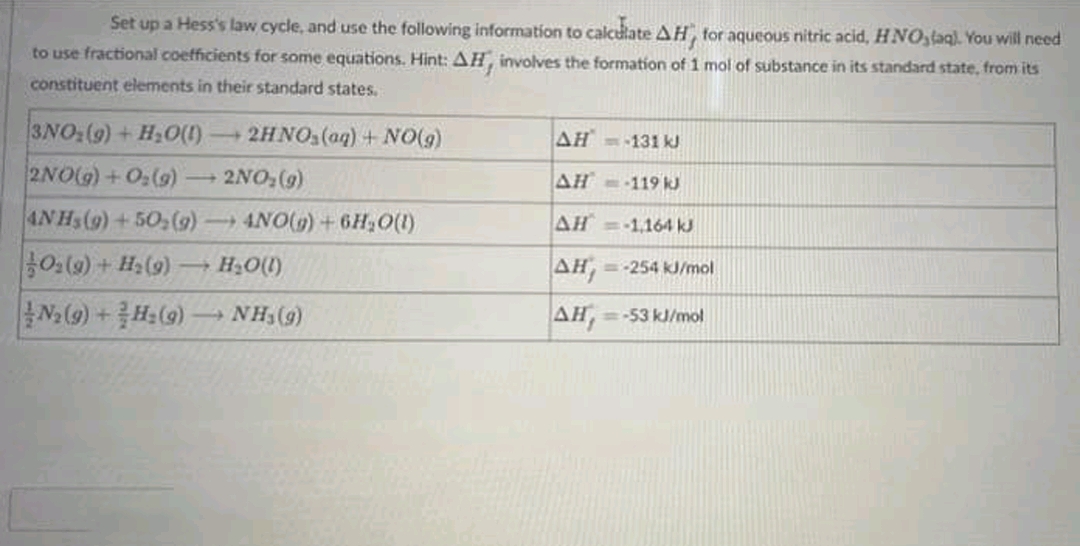Set up a Hess's law cycle, and use the following information to calculate AH, for aqueous nitric acid, HNO,taq). You will need to use fractional coefficients for some equations. Hint: AH, involves the formation of 1 mol of substance in its standard state, from its constituent elements in their standard states. 3NO:(9) + H,0(1) 2HNO,(ag) + NO(g) AH 131 kJ 2NO(g) + O:(9) 2NO,(9) AH = 119 J 4NH3(9)+50,(g)4NO()+6H,0(1) AH-1,164 kJ 0:(0) + Ha(9) H;O() AH, =-254 kJ/mol N() +H:(0) NH,(9) AH, =-53 kl/mol %3D
Set up a Hess's law cycle, and use the following information to calculate AH, for aqueous nitric acid, HNO,taq). You will need to use fractional coefficients for some equations. Hint: AH, involves the formation of 1 mol of substance in its standard state, from its constituent elements in their standard states. 3NO:(9) + H,0(1) 2HNO,(ag) + NO(g) AH 131 kJ 2NO(g) + O:(9) 2NO,(9) AH = 119 J 4NH3(9)+50,(g)4NO()+6H,0(1) AH-1,164 kJ 0:(0) + Ha(9) H;O() AH, =-254 kJ/mol N() +H:(0) NH,(9) AH, =-53 kl/mol %3D
Principles of Modern Chemistry
8th Edition
ISBN:9781305079113
Author:David W. Oxtoby, H. Pat Gillis, Laurie J. Butler
Publisher:David W. Oxtoby, H. Pat Gillis, Laurie J. Butler
Chapter12: Thermodynamic Processes And Thermochemistry
Section: Chapter Questions
Problem 44P
Related questions
Question

Transcribed Image Text:Set up a Hess's law cycle, and use the following information to calculate AH, for aqueous nitric acid, HNO,taq). You will need
to use fractional coefficients for some equations. Hint: AH, involves the formation of 1 mol of substance in its standard state, from its
constituent elements in their standard states.
3NO:(9) + H,O()
2NO(G) + 0:(9) -
- 2HNO,(aq) + NO(9)
AH =-131 kJ
2NO, (9)
4NHS(9) +50,(g)4NO(9) +6H,0(1)
|용0:(9) + Hs(9)→ Hs0(0)
AH= 119 kJ
-
AH = 1,164 kJ
AH,
=-254 kJ/mol
Na (9) +H:(9) NH,(9)
AH,
-53 kJ/mol
Expert Solution
This question has been solved!
Explore an expertly crafted, step-by-step solution for a thorough understanding of key concepts.
This is a popular solution!
Trending now
This is a popular solution!
Step by step
Solved in 2 steps with 2 images

Knowledge Booster
Learn more about
Need a deep-dive on the concept behind this application? Look no further. Learn more about this topic, chemistry and related others by exploring similar questions and additional content below.Recommended textbooks for you

Principles of Modern Chemistry
Chemistry
ISBN:
9781305079113
Author:
David W. Oxtoby, H. Pat Gillis, Laurie J. Butler
Publisher:
Cengage Learning

Chemistry: An Atoms First Approach
Chemistry
ISBN:
9781305079243
Author:
Steven S. Zumdahl, Susan A. Zumdahl
Publisher:
Cengage Learning

Chemistry
Chemistry
ISBN:
9781305957404
Author:
Steven S. Zumdahl, Susan A. Zumdahl, Donald J. DeCoste
Publisher:
Cengage Learning

Principles of Modern Chemistry
Chemistry
ISBN:
9781305079113
Author:
David W. Oxtoby, H. Pat Gillis, Laurie J. Butler
Publisher:
Cengage Learning

Chemistry: An Atoms First Approach
Chemistry
ISBN:
9781305079243
Author:
Steven S. Zumdahl, Susan A. Zumdahl
Publisher:
Cengage Learning

Chemistry
Chemistry
ISBN:
9781305957404
Author:
Steven S. Zumdahl, Susan A. Zumdahl, Donald J. DeCoste
Publisher:
Cengage Learning


Chemistry & Chemical Reactivity
Chemistry
ISBN:
9781133949640
Author:
John C. Kotz, Paul M. Treichel, John Townsend, David Treichel
Publisher:
Cengage Learning

Chemistry: The Molecular Science
Chemistry
ISBN:
9781285199047
Author:
John W. Moore, Conrad L. Stanitski
Publisher:
Cengage Learning